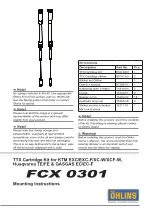
5
17/0,PIR,T0
Input No:
Six categories are defined in the system which will be
automatically detected by the DGP. Per category there
are several types to indicate a sub group.
For I/O there is i.e. AD011, AD111 which are types T2
and T3 respectively.
Category List
MISC
Miscellaneous
PIR
PIR devices
GLASS
Glass break devices
CSMOKE
Conventional smoke
devices
ASMOKE
Analog addressable smoke
devices
IO
I/O devices
Devices not known to the system (not learned) will show
as “Not used”. A “$” in front of the device category indicates
the device holds settings other than default settings. When
devices share the same address by accident, the text
“Multiple devices” is shown. Check the address settings
of the devices to cancel the fault.
To scroll through the list, use ENTER or MENU. Press 0
ENTER to exit. Press zone number ENTER to get detailed
status information for a device. Use ENTER or MENU to
scroll through the device-range. To exit press 0 ENTER.
3. Device settings
Shows a selection list as in menu 2. Press zone number
ENTER to enter the configuration menu. Now all
configuration locations can be entered. Use the MENU
key to toggle between value or bit presentation.
Using value-presentation, enter a decimal value between 0
and 255. Using bit presentation, press the bit number (1 to
8) to toggle the bit between 0 and 1. See the device manual
for information regarding the available settings.
Press ENTER to move to the next location.
4. Reset settings
Shows a selection list as in menu 2. Press zone number
ENTER to reset the device setting for a specific device.
Confirmation is required before the settings are reset to
factory defaults. When the settings are unknown, all
locations will be set to 0.
5. Learn mode
Equal to shortening the JP2 jumper for a few seconds. Will
enter the learn mode by which devices become known to the
system. Press MENU to start. The learn mode sequence can
take some time. While in learn mode, the DGP will show
“DGP is learning, please wait”. Do not leave this menu
before the learning has ended.
6. DGP Mode
Select the number of DGPs and expanders to use and select
the polling mode. The number of DGPs can be
set by pressing the MENU key to:
1 DGP address: allows for a total of 16 inputs and
16 outputs
1 DGP + expansion: allows for 32 inputs and 16 outputs
2 DGP addresses: allows for 32 inputs and 32 outputs.
Required also for polling to be enabled for the DGP address
selected by the DIPswitch and the next higher DGP address
(total of 2 DGP addresses).
Default polling mode is extended. In case older
products/firmware is used, the mode should be set to
standard mode.
7. Factory defaults
Returns all settings to factory defaults including all device
settings. Confirmation is required before the settings are
reset to factory defaults. During defaulting, the message
“DGP is DEFAULTING, Please wait” will show in the display.
Do not leave this menu until the defaulting process has been
finished.
Technical Specifications
Power supply (CON1)
10.5 – 13.8 V
Supply Current (at 13.8 V
± 5%)
53mA (no PID device connected)
PointID power supply (CON2)
9.9 – 13.2V
+additional data-pulses
Max PointID output current (at 13.2V
± 5%)
154mA (Max Unit load 512)
Dimensions
80 mm x 90 mm
Weight 160
gr.
Temperature
10°C to +50°C
Relative humidity
95 %
Note:
When using an external power supply, provide power through a fused power supply output (13.8 V
1A max)
Содержание ATS1290
Страница 24: ......






































